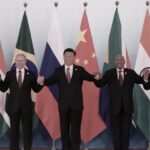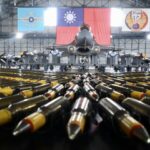By Andrew Moran
Russia is easing its dependence on the U.S. dollar and quickly growing reliant on the Chinese yuan, which could turn out to be either a boon for Moscow or a substantial risk, experts warn.
Over the last year, the Russian economy has been restricted from Western financial networks and has faced economic and political sanctions over its invasion of Ukraine in February 2022. Russia has also been prohibited from using the U.S. dollar, forcing the Kremlin to turn to the Chinese yuan as an alternative.
President Vladimir Putin has expanded his country’s relations with Beijing, particularly on the energy front.
Russia’s Exports to Beijing
“According to the results of this year, Russia has become one of the leaders in oil exports to China,” Putin said at the beginning of a video conference with Chinese President Xi Jinping in December.
Russia’s exports of discounted crude and fuel oil to China surged to record levels in January, topping the previous high established in April 2020. According to data intelligence firm Kpler, crude and fuel oil flows to China increased to 1.66 million barrels per day to kick off 2023. With the world’s second-largest economy reopening its markets after abandoning its COVID-Zero strategy, market experts anticipate that the energy trade could grow at a far more significant pace.
But while Russia is using the revenues from its sales of discounted energy products to China to fund its war in Ukraine, Beijing benefits in many ways. The first is the $13-a-barrel savings on Russian Urals, which presently trade at around $60 per barrel. The second is that another significant market is relying on the Chinese yuan.
Data compiled by The Wall Street Journal show that domestic energy exporters are being paid in yuan. The nation’s sovereign wealth fund, which is a war chest to ensure the Kremlin pays its bills, is utilizing the yuan to maintain its oil-driven revenues. Last summer, major companies, such as aluminum king Rusal, energy giant Rosneft, and lending firm Bistrodengi, began issuing yuan-denominated bonds inside Russia. In addition, a growing number of companies are borrowing capital in yuan, while households have deposited approximately $6 billion worth of Chinese currency in Russian banks.
With the ruble under attack by the international community and broader discussions about the end of the dollar hegemony, many consumers turned to the yuan for shelter.
Although dollars and euros still account for most of the Russian export settlements, the prevalence of payments in the yuan and even the ruble is increasing.
Sanctions on Russia
Meanwhile, the Ministry of Finance announced in February that it would sell more than 5 percent of its yuan stockpile. The Russian government is drawing down from its reserves to cover a budget shortfall driven by a 46 percent year-over-year decline in energy revenues in January.
Western governments have imposed tighter sanctions on Russia’s petroleum exports, while crude oil prices have slumped on global recession fears and central bank policy tightening. The Urals crude blend is down about 30 percent from a year ago.
Despite the latest developments, some estimates suggest that drawing down from its yuan reserves could allow Russia to cover its fiscal holes for as long as three years.
For now, this might be the only option for Putin and Russia. But observers warn that this could have ramifications for Moscow.
“Russia is swapping its dollar dependence for reliance on the yuan. Should relations with China deteriorate, Russia may face reserve losses and payment disruptions,” wrote Alexandra Prokopenko, an independent analyst at the Carnegie Endowment for International Peace.
At the same time, Putin may be attempting to improve the ruble’s standing and circumvent Western sanctions by rolling out a digital ruble in April. The Bank of Russia will be working with 13 financial institutions and pre-selected businesses to participate in a central bank digital currency (CBDC) pilot project, local news media reported.
Officials say that Moscow is exploring a new digital format for international settlements as part of broader efforts to manufacture a new financial and monetary system for the post-invasion economy.
Rise of the Yuan
Russia’s yuan utilization could be considered progress for China’s greater objective of expanding the yuan’s reach in cross-border commerce.
In addition to Russia embracing the Chinese currency, more countries are considering settling their trade with China in yuan.
The Iraqi government confirmed to Reuters that it is taking steps to permit trade from China to be settled directly in yuan amid the nation’s U.S. dollar shortage.
“It is the first time imports would be financed from China in yuan, as Iraqi imports from China have been financed in [U.S.] dollars only,” said Mudhir Salih, the government’s economic adviser.
Last year, The Wall Street Journal published a report that stated Saudi Arabia had been considering accepting yuan instead of dollars for Chinese oil sales.
Speaking in an interview with Bloomberg in Davos, Switzerland, for the World Economic Forum in January, a Saudi official revealed that the Kingdom is open to discussing trade in currencies other than the greenback.
“There are no issues with discussing how we settle our trade arrangements, whether it is in the U.S. dollar, whether it is the euro, whether it is the Saudi riyal,” Finance Minister Mohammed Al-Jadaan said. “I don’t think we are waving away or ruling out any discussion that will help improve the trade around the world.”
The United Arab Emirates has bolstered bilateral commerce with China, with trade topping $75 billion in 2021.
This has experts wondering if the Middle East is preparing for a collapse of the petrodollar and is bracing for the rise of the petroyuan.
“China has shifted its investments into the Gulf. The level of project-based, economic, and military cooperation is surpassing cooperation with the U.S. on many levels, and trade is likewise being reoriented toward China from a balance towards a preferred system,” Irina Tsukerman, a geopolitical analyst and the president of security advisory firm Scarab Rising, told The Epoch Times.
New Basket Reserve Currency
But China is even planting a presence in South America after the People’s Bank of China (PBoC) announced last month that it signed a memorandum of understanding (MOU) on establishing yuan clearing arrangements in Brazil.
Trade between the two nations totaled $172 billion last year.
However, in June 2022, Putin announced that BRICS (Brazil, Russia, India, China, and South Africa) members were designing a new basket reserve currency that would attempt to undermine the dollar’s dominance. This could be a more realistic option in the intensifying worldwide de-dollarization campaign, Tsukerman says.
“A mixture of BRICS currencies is a more likely candidate for de-dollarization than the Chinese yuan by itself due to inherent weaknesses in the yuan and China’s own economy. Most countries simply do not see the yuan as reliable enough to make the switch,” she stated.
ING global head of markets Chris Turner stated in a note that this is likely to “address the perceived U.S.-hegemony of the IMF,” adding that it would “allow BRICS to build their own sphere of influence and unit of currency within that sphere.”
But Nouriel Roubini, the chief economist at Atlas Capital Team, suggests that the global financial system will grapple with a “bipolar” currency regime that “will eventually replace the unipolar one.”
Writing in a Financial Times column last month, Roubini purported that the international economy is being fractured by American and Chinese influence. Although some experts aver that China’s rigid currency controls would prevent the yuan from ever surpassing the buck, Roubini believes the U.S. maintains its own unattractive features “among foes and relative friends.”
“These include financial sanctions against its rivals, restrictions to inward investment in many national security-sensitive sectors and firms, and even secondary sanctions against friends who violate the primary ones,” Roubini wrote.
According to the International Monetary Fund’s (IMF) Currency Composition of Official Foreign Exchange Reserves (COFER), the yuan’s share of total foreign exchange reserves tumbled more than 7 percent year-over-year in the third quarter to below $298 billion. By comparison, the U.S. dollar representation also declined about 9 percent to $6.441 trillion.






